I’ve been selling on Amazon for a few years now and despite trying out several other online marketplaces, I still believe that Amazon FBA is the best business model for launching a new products business.
You can start getting sales with relatively little work, compared to selling your products on your own site or through trade shows.
In this Amazon FBA guide for beginners, I go through step by step exactly what you need to do in order to find a product to sell, finding a manufacturer, organizing your shipping, and getting your first sales.
What is Amazon FBA?
So what is Amazon FBA? When you purchase products through Amazon, especially when you aren’t buying household name items, then you are probably buying from someone like me.
Thanks to Amazon FBA, small businesses and entrepreneurs like you and me can start selling products on Amazon marketplace without having to set up delivery networks or storage facilities. Amazon FBA has enabled me to sell my products in the US even though I’m UK based which is amazing when you think about it!
When you sign up to Amazon FBA, Amazon stores your products for you and ships them to your customers on your behalf. They also deal with returns too. You simply ship your products in bulk to one of their fulfillment centers and then Amazon takes care of the rest.
For an additional fee, you can also get Amazon to do your product labeling and product photography, but I don’t do any of this. I prefer to have control over this part of the process.
Most of the time Amazon customers don’t even realize that they’re buying from a FBA seller. As far as the customer is concerned they order the product and it is shipped with Amazon Prime, they get a confirmation from Amazon, they return the product to Amazon (if necessary) and leave the review on Amazon.
Here is a product on Amazon that is sold by Amazon FBA, as you can see it looks the same as any other listing:
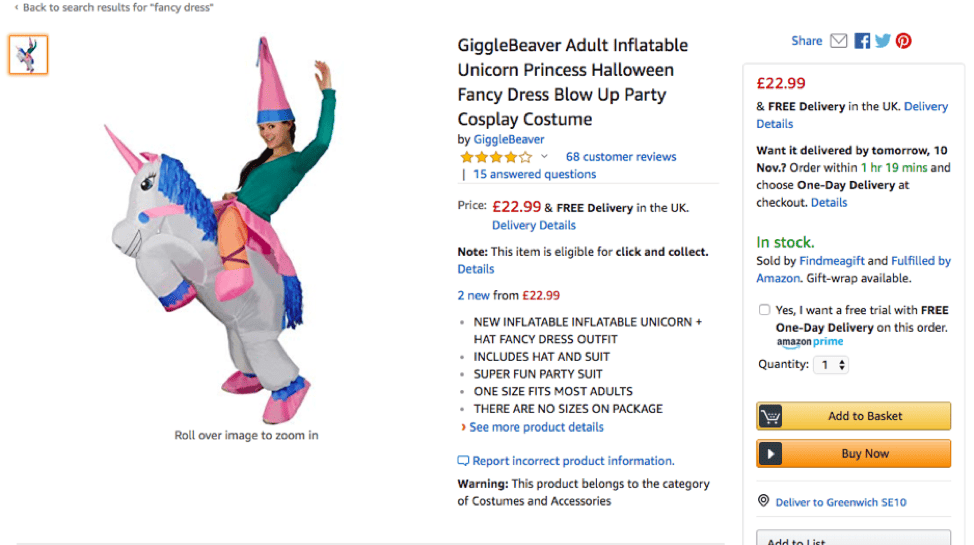
You don’t have to use Amazon FBA if you sell on Amazon, in fact many sellers fulfill their products themselves (it’s called Merchant Fulfilled), and this is particularly great if you are a handmade seller.
But in this article we’ll be focusing on how to start an Amazon FBA private label brand.
What is Amazon Private Label?
Amazon private label is another term for starting your own brand on Amazon. A few years ago Amazon sellers used to be able to sell pretty much anything on Amazon and make money, as the growth of Amazon was so quick.
Nowadays however, you need to think a lot more about the quality and the brand of your products. This is why I call it starting a private label brand, rather than starting an Amazon brand.
When you create a private label brand, you are choosing the products to sell, designing the products and packaging, and building a brand around your products. This is different to simply choosing some products and putting them straight on Amazon, and it is also better as firstly it’s more fun, but more importantly a brand is an asset that can be sold later on.
Why I Started Selling on Amazon FBA
Like a lot of people I stumbled into selling on Amazon FBA (which stands for Fulfillment by Amazon) while looking for ways to make some side income. I used to be a management consultant for Accenture and other smaller consultancies, and I really didn’t enjoy it day to day. I was working long hours and for not much reward, so I looked for a way to make some money and hopefully replace my salary.
I’ve spent a lot of time researching different business ideas over the years (I even thought about starting a funeral business at one stage – lucky escape there!) but Amazon FBA appealed to me at the time for a couple of reasons:
- Firstly, I’ve always liked the idea of selling physical products – there’s something really rewarding about creating and selling your own product from scratch. I was looking forward to the process of designing the labels, receiving product samples and selling!
- Secondly, from my research it looked like selling on Amazon would be something I could do in my free time. This was really important to me as I wanted the security of being able to stay in my full-time job while I worked out whether Amazon was right for me.
Most of the business ideas I had considered in the past either required a lot of upfront investment or required me to give up a lot of time – neither of which I had a lot of! So my girlfriend (now wife!) and I decided that Amazon FBA was worth a shot.
Turns out my first impressions were kind of right – selling on Amazon is pretty straightforward to do as long as you follow the right steps. Easy doesn’t equal no work though. It does take quite a lot of effort to set up an Amazon FBA business and at the end of the day, it is a real business and you need to treat it as such.
However, once you are up and running you can make a really decent income from Amazon FBA. It’s just not exactly passive income as some gurus will tell you.
It is totally possible to start an Amazon business as a side project whilst you are still at work – that’s exactly what I did for 2 years. You can work on your Amazon business in the evenings and keep your pay-cheque coming in which really takes the pressure off.
I run the business with my wife which works really well as we both have different strengths – she’s better at the numbers, while I really love coming up with product ideas and marketing. After a couple of years, we got to the point where I was able to quit my job and work on the business full time.
I think Amazon FBA can be a great way to start a business. In this guide I’ll show you how to make money on Amazon FBA and the steps involved in setting up an Amazon FBA business.
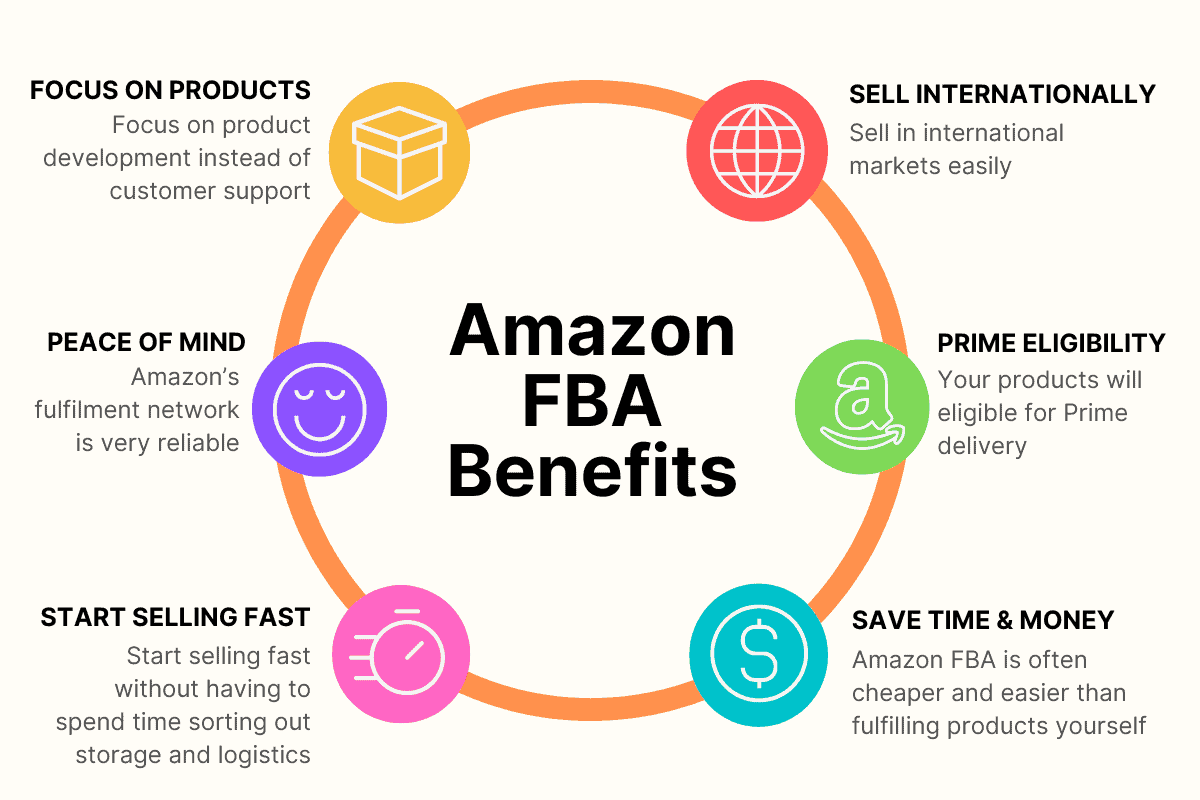
Benefits of an Amazon FBA Business
As you’ve probably guessed I think there are some serious benefits with the Amazon FBA programme, particularly for small businesses or new sellers:
1. Start Selling Fast
You can start selling on Amazon quickly and with relatively low investment because you don’t have the hassle or cost of sorting storage and delivery to customers.
2. Focus on Product Sourcing and Development
Amazon handles most of the customer support and returns, leaving you time to focus on product development and marketing.
3. Sell Internationally
Through Amazon FBA, a UK based seller can sell on Amazon.com and sell products to US customers by shipping products in bulk to Amazon fulfillment centers in the US. This is what I do, and it’s incredible when you think about it.
4. Save Time and Money
Amazon FBA is often cheaper and easier than fulfilling products yourself – Amazon has cheaper delivery rates than most local delivery services and you don’t have to spend time in your local post office!
5. Peace of Mind
Amazon’s fulfillment network is amazing – it’s so fast and reliable that you don’t need to worry about your products getting to customers on time.
6. Eligible for Amazon Prime
If your products are fulfilled via FBA then they will also be eligible for Prime delivery which gives you a significant advantage over sellers who don’t offer Prime delivery, particularly during busy buying periods like Christmas.
Amazon FBA is a really easy way for sellers to expand their business and build a global customer base without all the challenges that come with building an international fulfillment network. It can be absolutely game-changing for a small business.
What is the Difference Between FBA and FBM?
Amazon FBA and Amazon FBM are essentially different fulfillment options.
Amazon fulfillment (FBA), is an Amazon program whereby Amazon arranges product storage, packing, shipping and returns on behalf of sellers. That is what we are talking about in this article.
You simply ship your products in bulk to Amazon’s distribution centers and then Amazon will take over distributing products to customers and handling returns.
Of course, there’s a fee for this service!
Fulfilled by Merchant (FBM) means that you are responsible for storing your products, packing and shipping them to your customers, as well as handling returns. It is more like the traditional model of online retailing.
FBM works if you are already established as a brand and have warehouses or 3PLs to manage the shipping. However, even big established brands that I have worked with use FBA for its efficiency!
What are the Fees For Selling on Amazon FBA?
Of course, there is a cost to using Amazon FBA but it really depends on your personal circumstances and the products you’re selling as to whether it’s worth it for you.
When you use FBA, you’ll pay the following fees:
Amazon FBA Fees
FBA fees vary depending on the size and weight, but I generally work on the basis that 30-35% of my sales price will be paid to Amazon in fees. Bear in mind that if you’re selling products for less than $20 then you might not be left with much profit.
Referral Fees
Referral fees are essentially the commission. Amazon takes a cut of every sale you make, and for most categories it is 15%. For some categories, it is less or more, but for the majority of categories, it is 15%. You pay the referral fee if you are using FBA or FBM.
FBA Storage Fees
Monthly storage fees can get expensive if your products don’t sell quickly. If you don’t sell your items within 6 months, Amazon charges a higher per-month storage rate.
How Do Amazon FBA Fees Work?
Amazon automatically deducts the fulfillment fee from the price the customer pays on Amazon. The FBA fee is a flat fee that you pay on each product sold based on the product type and the size and weight of the product.
Storage fees are charged on a monthly basis and are based on how much space your products take up in an Amazon warehouse (Amazon calculates this as the daily average volume in cubic feet per month). The fee varies throughout the year with prices increasing during October to December.
The fees for selling via FBA often work out cheaper than storing and sending products to customers yourself, plus it’s a lot less work! Imagine having to go and queue up every day at your local post office to ship your orders!
But the FBA costs all have an effect on your overall profit margin, so it’s important to factor in what sort of margin you are going to need. For example you also need to pay a ‘referral fee’ which is basically Amazon jargon for commission. This commission is 15% for most product categories, but for some it is more, for example for kindle related products.
So it’s really important you understand these fees, because they will help you to understand your profit. At the end of the day, this is a business, and you want to know how much dough you’re going to get after all the fees!
EXAMPLE
Let’s say you’re selling a water bottle for £20. The breakdown of the fees might look something like this:
Sale price of product: £20
Cost of manufacture: – £4.00
Shipping and import taxes: – £5.00/air £2.00/ship
FBA fees: – £3.75
Amazon referral fee (15% for most items): – £3.00
Profit: £4.25 or £7.25. Nice!
How to Use the Amazon FBA Calculator
Amazon has a reasonably handy calculator to help you estimate what sort of fees and additional costs you’re going to pay, however Helium 10 has an even better one called the profitability calculator (more on that further down).
The best thing about the Helium 10 version of the Amazon FBA calculator is it helps you to work out what the FBA fee will be based on the size and weight of your product. This is really handy, because Amazon’s own FBA calculator makes you find a similar product and input that into the calculator first. Basically the Helium 10 version saves you a step.
You can see on the picture below the FBA fee of $6.75 is because the weight is 3.06lb and the dimensions of the box is 1.46 x 12.56 x 12.87 inches. This is such a handy tool and I literally use it every day in my business.
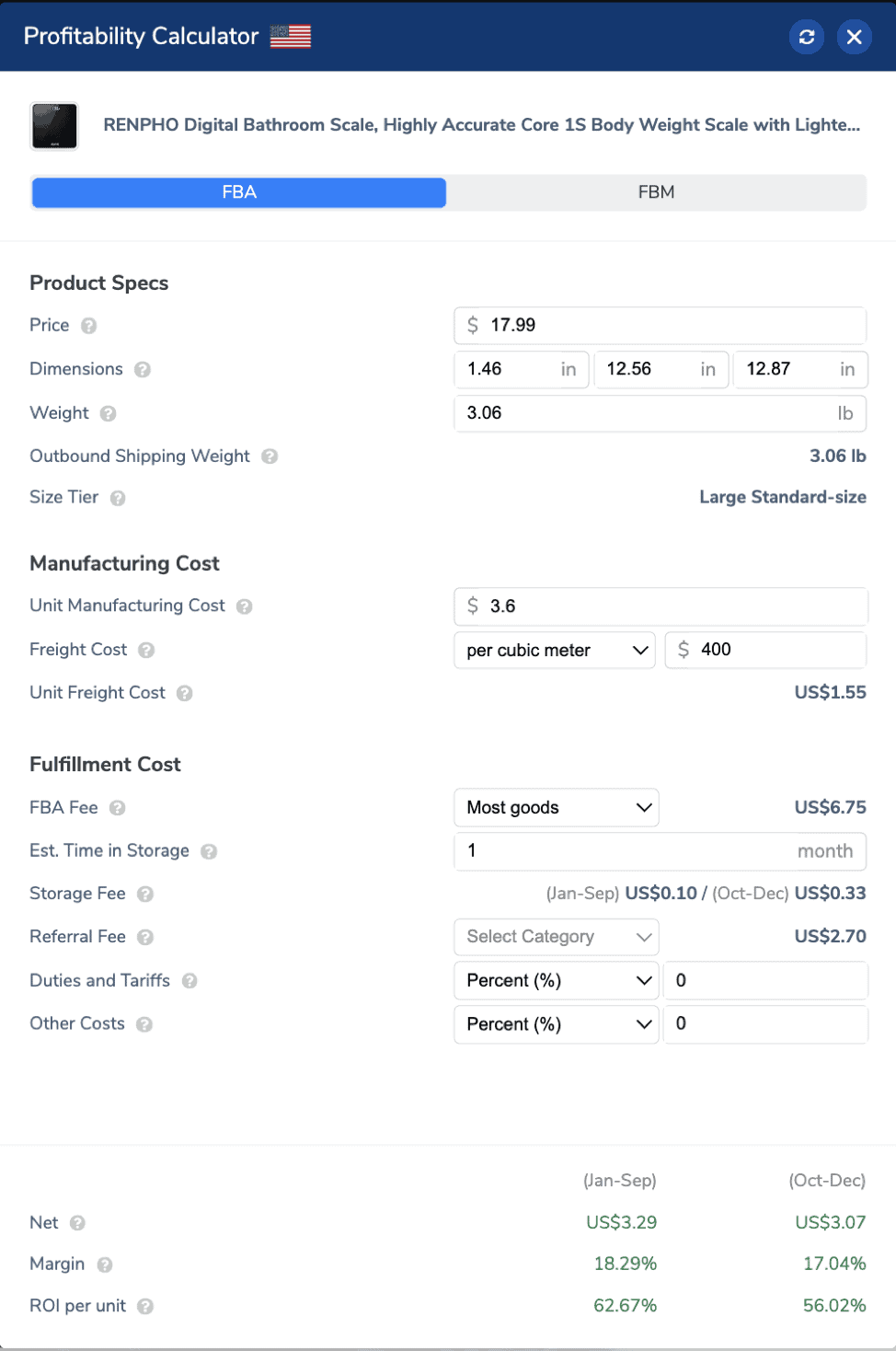
What to Sell on Amazon FBA
First things first you need to come up with some product ideas – this is the part I really enjoy!
Amazon is this amazing place where you can buy pretty much anything from tampons to tablet computers, so no idea you have is going to be too silly to sell, it’s just about finding profitable products.
Product sourcing is something me and my girlfriend always work on together as we both come up with totally different ideas and challenge each other’s assumptions.
There are lots of different ways to generate product ideas – I actually covered some of my favourite tactics in this video.
Helium10 has another tool which can also help with product ideas called Black Box. It allows you to filter products across loads of different categories by demand, selling price, estimated sales, rating, seasonality, sales history, and dimensions.
Top tip – Don’t compete with well-known brands
Don’t try to compete with household brands. This applies to some products more than others. For example, if you search for “football” on Amazon you may find that the search results are dominated by household names like Nike and Adidas.
There is no point competing with Nike, if I want a Nike football I will buy a Nike football. But if I want a football pump, I wouldn’t necessarily care what brand it is and you’ll find that the search results show a lot more smaller companies (some of which will be FBA sellers!). These are the sort of products we are looking for.
How to Rank on Amazon (Amazon SEO)
When thinking about product ideas it’s also important to remember how Amazon ranks products. Sometimes you’ll see this referred to as Amazon SEO or Search Engine Optimization because essentially Amazon is a search engine, like Google which shows results when you type in a search query. And just like on Google, you want to optimize your SEO so you appear high up in the results.
Amazon uses an algorithm (A9) to determine how products are ranked in the search results. The algorithm considers a range of factors but in general terms it’s looking at performance and relevance to determine which order to rank products in.
Amazon prioritizes those listings that perform best ( i.e. the listings that have the highest sales conversions and which have the best reviews) and those products that are most relevant ( i.e. the listings which most closely match what the customer has searched for).
I’ll discuss this in more detail later on in the guide but it’s important to have an understanding of how Amazon ranks products in order to analyze competitor products and potential product ideas.
How to Do Product Research On Amazon
There are a few things to keep in mind when coming up with the perfect product to sell on Amazon FBA:
1. Price
Ideally you need to sell your product for at least $20. Any less than that and your profit margin will be so low that you’ll need to sell thousands to make any money. Remember Amazon’s fees!
2. Size
When you are learning how to sell on Amazon, it’s best to focus on small products (ideally your dimensions should be 45 x 34 x 26 cm or 18″ x 14″ x 8″ and the weight should be less than 5kg or 10lb). Amazon has product size regulations and larger products incur higher fees. That doesn’t mean you can’t do larger products, it’s just better to keep your fees low while you’re learning the ropes.
3. Competition
You don’t want too much competition for a product. The more competition you have, the more money you will have to spend on advertising in order to get onto page 1 so steer clear of high-competition areas (like yoga mats!) when you’re first starting out.
4. Sales
Have a look at similar products on Amazon, are they selling well? What keywords are they using? You need to check that there’s enough demand for your product using the tools I discuss below.
5. Complexity
When you’re first starting out, it’s best to avoid complicated products. The more complex the product, the more things that can go wrong and the more returns you’re at risk of getting. A lot of returns will hurt your profit margin and your Amazon ranking.
Seems simple enough doesn’t it! Product analysis gets easier the more you do it. After a while you’ll get a sense for what kind of products are likely to be high competition and what’s likely to be too complex. But in order to help you make these decisions, you’re going to want to use some tools.
Product Research Tools
Your competitors are one of your best sources of information. You can analyze their sales and listings to determine how much demand there is for your product idea and how easy it will be to compete.
My favorite tool for analyzing competitors is Helium10. When starting an Amazon FBA business, this will become your best friend. Helium10 has a whole range of different tools but my favorites are Xray and Cerebro.
Xray is Helium10’s Google chrome extension which allows you to analyze product sales just by going on a competitor’s listing and clicking a button. You can even go onto a search page and use Xray. It tells you invaluable information such as monthly sales for each product, what the product fees are, and whether a product is FBA or merchant fulfilled. They have a huge product database of all the products on Amazon, so the data is really good.
Here is what it looks like:
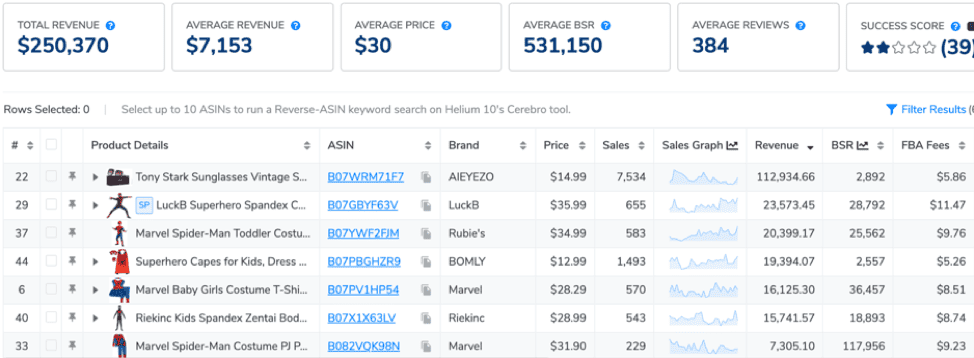
How cool is that! Some of these guys are making loads of money each month!
With the Cerebro tool, you just enter the ASIN for the competitor product you’re interested in and you get a long list of all the relevant keywords and the search volume for those keywords.
Helium 10 can be expensive, it’s $99 per month, but I think when you are starting out you can just get it for a month or two and then put it on pause until you find your product.
There is also a free version, which gives you a limited number of uses until you need to upgrade. If you use this link to get Helium 10 or use these codes, you can get 50% off your first month or 10% off your first year.
If Helium 10 is a bit expensive for you right now, have a look at some of the cheaper Helium 10 alternatives I’ve tested.
How to Analyze Search Volume
Understanding how keywords work is really important when you are starting out selling, as keywords are what the customers are using to find products. Search volume is the number of people searching for a particular keyword over the last month. Remember, the tools only give you an estimate, so use them as a guide rather than relying on them exactly.
The main tool I use to analyze search volume is Helium 10’s Cerebro tool. The tool shows you the relevant keywords your competitor is ranking for, which is why it is so powerful. For example, when I look at this digital scale, I can see that it is ranking for “scale for body weight” and that keyword has 187,042 searches each month!
This is great data to help you find products, as now you can go and search for that keyword on Amazon, and if you think you could make a product that will rank, then that could be a good product for you to make. I make a keyword list for all these relevant keywords and keep them for writing my listing.
This tool is called Cerebro, there is a link to get it here.
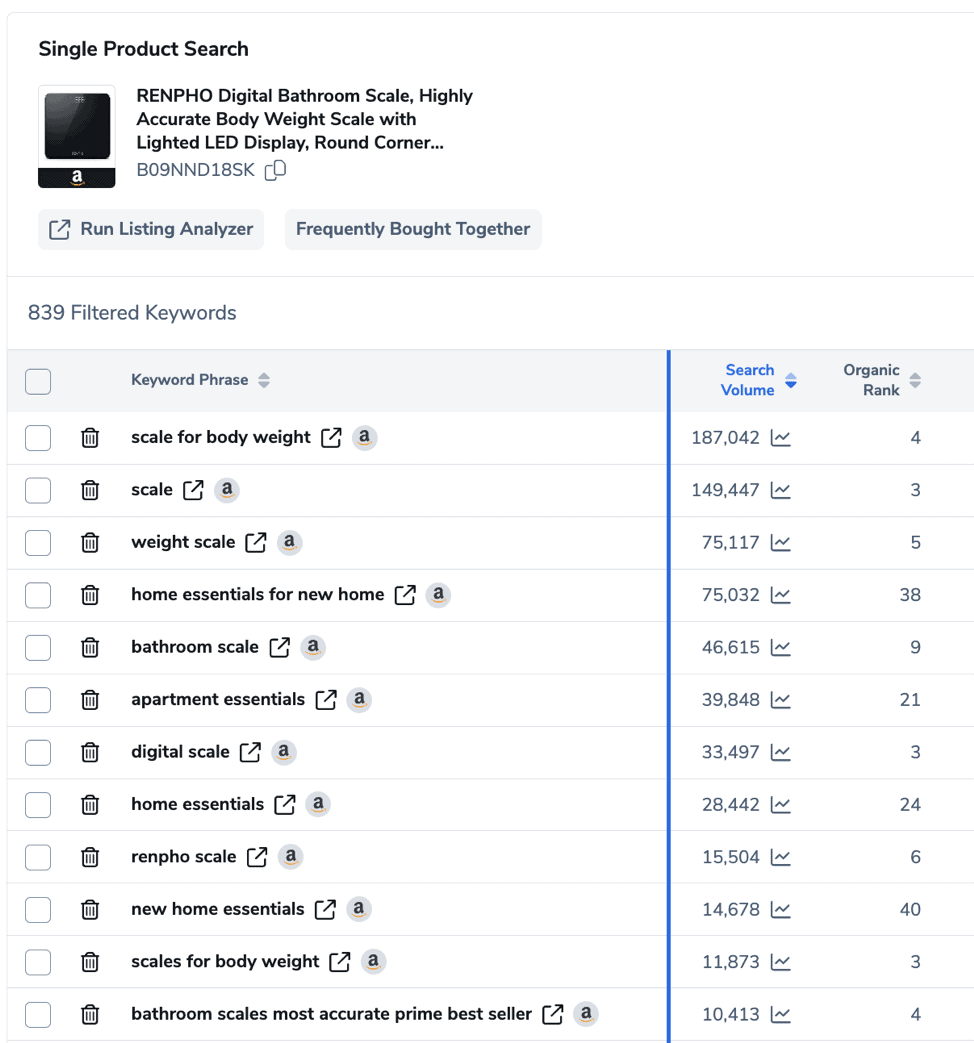
How to Create the Perfect Product for Amazon FBA
Product selection is the most important factor when starting an Amazon business, but once you’ve got an idea you need to think about how you’re going to make it stand out.
It’s important that you don’t simply copy another product. Firstly, it’s unethical to copy someone else’s product design and secondly it’s going to be very difficult to compete as a new Amazon seller.
But you can take inspiration from what is selling well on Amazon and try to improve upon it. Reviews are a great source of information for this. If you see some 3 or 4* reviews, this could be a good sign that there is room for improvement. Check out this yoga mat’s reviews:
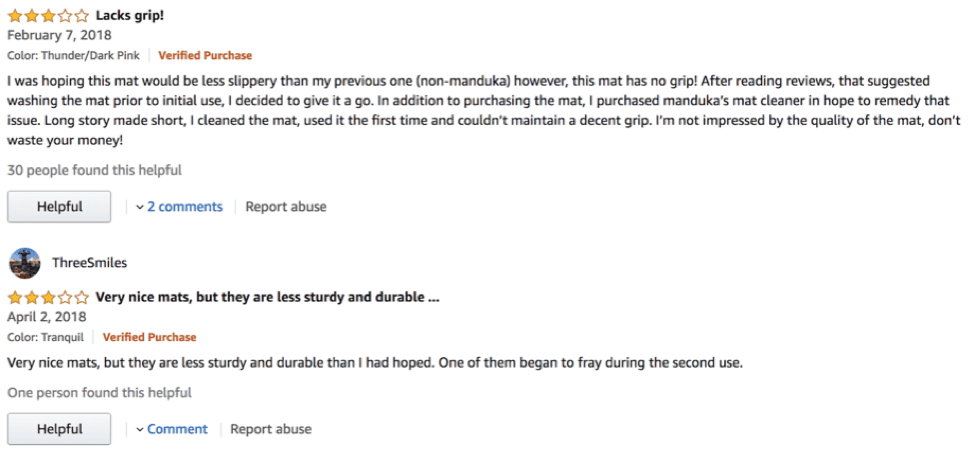
You can see here that the mat lacks grip and 30 people have found that helpful. Another reviewer has said the mat is nice, but not very durable. This is some great info that you can use to make an improved yoga mat. Although I wouldn’t suggest yoga mats as it’s super competitive!
Other simple ways to make an improvement to a product include:
- Changing the color
- Changing the material
- Changing size
- Bundling the item into a multipack
- Changing the packaging to make the item giftable
How to Find Suppliers for Amazon FBA
Now you have your product idea and you’ve validated it you can start talking to manufacturers and ordering samples.
There are a number of ways to find suppliers – trade shows are a great place to look in my experience but I’ve also found suppliers in the past from old fashioned googling.
Alibaba is another place you can try to find overseas suppliers. Alibaba is a supplier database full of manufacturers selling pretty much any product you can think of. Here is a search for football pumps:
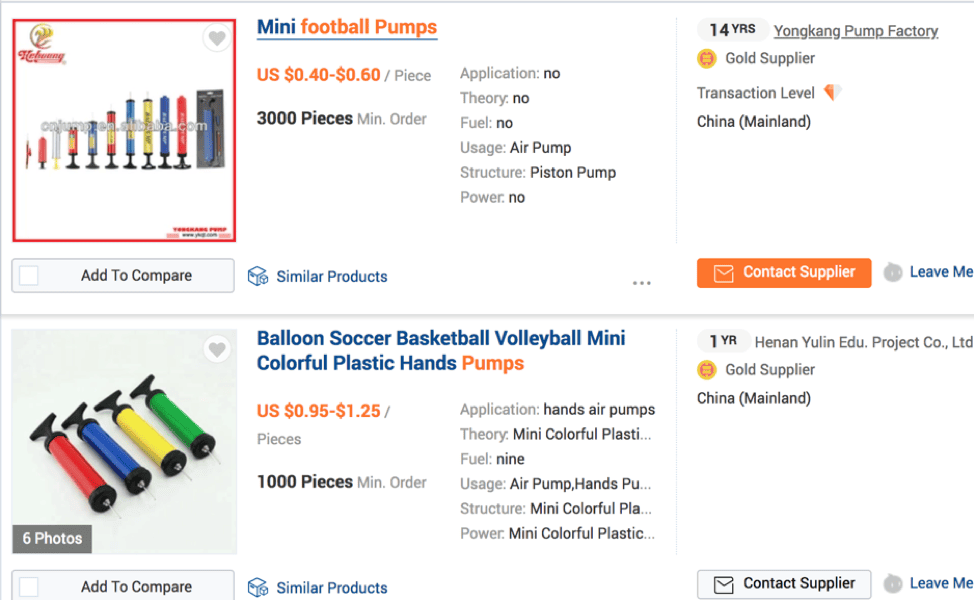
Personally, I like to try and find suppliers from outside Alibaba, as nearly every seller uses Alibaba. I really love to find suppliers at trade shows, as you get to feel the products and talk to the manufacturer.
I also like sourcing from countries outside of China, as I like to find really different products for my homeware brand. There are loads of different places to look for potential suppliers and too many to go into in one guide, but I go into trade shows in more depth here.
How to Talk to Suppliers
Make sure you have a clear idea of what you’re looking for before contacting potential Amazon FBA suppliers. Suppliers get a huge number of requests for information and they’re unlikely to give you the time of day unless they think you’re serious.
I usually put all my questions into an email like this:
Hello,
My name is Teddy from Teddy Industries.
We are looking to purchase football pumps for the UK and EU market. Here is a link to a similar product on Amazon. https://www.amazon.com/Fitness-Factor-Small-Dual-Action/dp/B0150TYVGY/ref=sr_1_1_sspa?ie=UTF8&qid=1548937643&sr=8-1-spons&keywords=football+pumps&psc=1
Our primary sales channel will be online although we will be selling in stores too. We estimate 5000 pcs annual purchase volume after a trial order of 200 pcs and samples evaluation.
The product specifications:
- Specifications: Size — 30 cm
- Material — Strong plastic
- Color — We would like to add our branding to it
- Style — traditional pump
- Additional features — I would like a travel bag for the pump
Do you manufacture these products? If so please provide the following.
- Photo, specifications and FOB quotation
- Are you a manufacturer or a trading company?
- What is your lead time for a sample?
- What is the lead time for a trial order?
- Can we add our logo to the label
- What is the sample cost including shipping to the UK?
Thanks, Teddy
Once I have the answers to the above questions from a few suppliers I would compare them all and choose my favorite to work with. Remember, overseas suppliers probably don’t have English as a first language. However, make sure they speak good English as it’s really important that you are able to communicate clearly.
How to Design a Product for Amazon FBA
Designing the product can take a long time, but you need to get this part right so avoid the temptation to race ahead. I always order samples so that I know exactly what I’m buying and I can feel the quality for myself.
If you’re struggling to communicate exactly what you have in mind to suppliers, then it might be worth getting some drawings done. If you need help with this you can find some great designers on Upwork or Fiverr.
Product Packaging
Product packaging is really important as it protects your products, promotes your brand and can even be used as a marketing tool to make you more sales. Successful sellers also use things called product inserts. These are usually little leaflets that promote your brand, help you get reviews and also show customers your other products.
When I am designing my packaging, I usually pay someone from Fiverr or Upwork to design it for me, as I am not great with designing! For one of my brands I found an ex-Marks and Spencer packaging designer. She was expensive, but the packaging she designed was so professional.
Packaging will really help you stand out from the crowd on the product search page, so it is important to make packaging that really promotes your brand and feels premium.
Insert an image here about packaging.
How to Ship to Amazon FBA
Shipping can seem like a daunting topic, there’s a lot to consider including tax, shipping costs, lead times, paperwork etc. The good news is there are a couple of ways you can simplify the process as a new seller.
Decide On Your Form of Shipping
Freight forwarders
A freight forwarder is basically an agent who sorts out the shipping, taxes and customs and everything else and charges a fee to do this. It simplifies the process from dealing with 5+ people to dealing with just one.
There are a number of different freight forwarders – two I’d recommend are Flexport and Unicargo – they’re both easy to use and have English speaking staff who are used to dealing with Amazon FBA businesses. Another one I really recommend is AEB logistics. If you want to get in touch with them, tell them Teddy Smith sent you and Alan will give you the best prices.
This is how it works:
- The factory organizes the stock to be delivered to your freight forwarder
- The freight forwarder sends the stock to your target country
- The freight forwarder pays the customs and paperwork
- The freight forwarder organizes the stock to be delivered to Amazon’s fulfillment centers
- You pay one bill which includes shipping fees, taxes and the freight forwarder’s fee.
Easy as that (usually)!
DDP
Another option is to get your manufacturer to sort out the shipping for you using a shipping process called DDP (Delivered Duty Paid). With DDP, the manufacturer will work with their recommended shipping company and handle all the delivery from door to door and then charge you a fee at the end.
This can be a really good option when you’re first starting out as there’s even less for you to worry about.
You need to decide whether you want to ship by air or sea. As a general rule, a shipment from China to the UK or the USA will take 4–8 weeks. By plane, it can take less than a week but it will cost you a lot more.
For your first few orders, I would recommend shipping by air, if you can, as you can get selling quicker and work out whether a product is going to work without having to wait 2 months for it to get to Amazon.
Air shipments are generally a bit more straightforward too – shipping by sea tends to involve more fees and paperwork. Air shipments became really expensive during Covid, but they have calmed down a little bit now. Ask about Air prices, and if you can’t get anything good value, then go by sea.
Create Your Shipping Plan
To send your products to Amazon, you need to create a shipping plan. This can be done in Seller Central, once you have created your account. To create your shipping plan with Amazon, you will need the dimensions, contents and weight of each master carton. A master carton will usually hold multiple individual units.
There are rules and restrictions on the size of each master carton, so make sure you are within the rules, or Amazon can get annoyed with you. Basically, they can’t be too big or heavy, and if they are big you need to put “heavy” on the box, so that staff members know they need two men to lift the boxes.
Amazon FBA Requirements
Amazon has certain rules around how you package up the products you send to their fulfillment centers:
FBA Packaging Requirements
There are also rules about the individual unit packaging, and if you make your packaging too big, then the fees can be much higher. Use the Helium 10 profitability calculator to work out the packaging size.
You also need to think about how your product is protected, as different types of products need different packaging. For example, if the product is glass you need extra bubble wrap protection. This is called the product prep guidance.
FBA Label Requirements
Each individual product also needs to have either a barcode or a GTIN exemption. The barcode could be a manufacturer’s barcode from GS1 or it could be Amazon’s FBA label.
Personally, I use Amazon’s barcode, even though I have a GS1 account. The reason for this is Amazon makes it easy to create stickers to attach to your packaging, and for me it’s better than printing a barcode on each box.
How to Set Up an Amazon Seller Account
Creating your Amazon account is not as straightforward as signing up for a buyer’s Amazon account.
There are 2 types of Amazon Seller account: Individual sellers and Professional sellers. With an Individual account, you pay a fee for each product you sell and with a Professional account you pay a monthly fee.
It’s really up to you which you pick but if you really want to start an Amazon FBA business I would go with a Professional account and get working faster!
I talk about how to set up your account successfully in this video, but there are a couple of general things to bear in mind:
- You can only have one seller account, so make sure that if you have ever had a sellers account, you use that account to register. Even if you only sold a few university books, you must either close the old account or register using that email.
- Amazon has strict rules about documentation so make sure you have everything in the right format before you apply. It’s very important that all the names and addresses match exactly on all documents in order to pass verification.
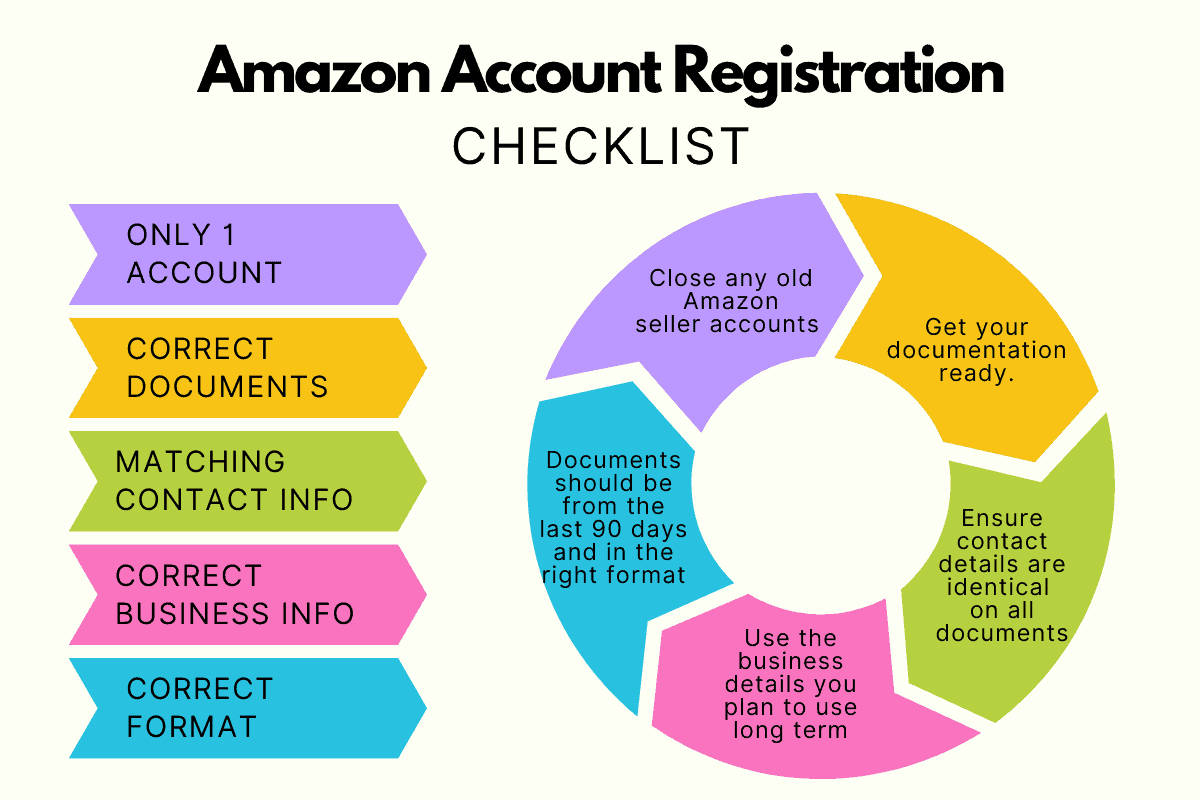
What Documents Do I Need to Sign Up For an Amazon Seller Account?
You will need the following documentation to get your account approved:
- Email address – This can be your personal email address, but I like to have a separate email for business and personal life
- Credit card – This is so Amazon can charge you if you don’t have any money in your account. Amazon asks for a credit card, but you can often get away with a debit card.
- Government ID – Passport, driving license etc
- Tax information – Your UTR or TIN
- Phone number – Your number
- Bank account – You want Amazon to send you some money!
What is Amazon Seller Central?
Once your application has been approved, you’ll have access to Seller Central. This is the online portal where you’ll find everything you need to run your Amazon Business, including your sales, analytics, product listings and how to contact Amazon.
I won’t include screenshots of it as Amazon is constantly updating it and moving things around, but it’s worth familiarizing yourself with where everything is once you’re registered.
How to List a Product on Amazon
Once you’ve set up your account, it’s time to create your product listing in Seller Central. I recommend writing your product listing in a word document before you upload it to Amazon.
Before you start you need a list of your relevant keywords. You will need to put these into your listing and in the backend keywords. You can use a tool like Helium 10 or AMZ Scout to get your keywords. AMZ scout is cheaper, but it’s still pretty good.
Here are my top tips for what to include in each section of your product listing. Remember to check the character limit for each section:
Product Title
- Use your most important 2 or 3 keywords in your product title
- Include the material, size, colour
- Keep it factual – don’t make claims like “best” or “top”
Bullet Points
- User your next most important keywords in the bullet points
- Use short, easy to read sentences – your first 3 bullets are the most important
- Talk about the benefits of your product not features
- Overcome any concerns / objections
- Don’t include any outlandish claims (be very careful with health products)
Product Description
- The product description is a longer section for you to tell the customers more about your brand
- Build an emotional connection with the buyer by talking about the product benefits and how the product would improve their lives
- Include instructions for using and looking after the product
- Include trust signals such as accreditation or industry awards if relevant
Search terms
- Only use relevant search terms
- No need to repeat keywords
- No punctuation, just spaces between keywords
- Include synonyms and local colloquialisms e.g. diaper / nappy
- Include Spanish words if selling on amazon.com
Subject Matter Keywords
- Use your top long tail keywords here
Product Images
Your product images are possibly the most important part of your product listing. I always use a professional photographer rather than computer generated images. You can use a designer to make infographics, and I use Fiverr or Upwork to find a designer.
Here are my top tips when it comes to product images:
- Use all available images
- Images should be least 2000 pixels on longest side so potential customers can zoom
- Main product photos must be alone on a white background – no badges or text
- Use infographics to demonstrate size, dimension, ingredients etc.
- Use lifestyle images with people interacting with your product
- Make sure all the lifestyle images are true to scale
- Show the quality and benefits of the product
Once you’ve drafted your listing, head to Amazon and click “create a new product listing”.
You need to select the category you will be selling in. You can either use the search engine to find the category or you can browse through the product categories. Have a look at a competitor product if you’re unsure. You will then be taken to the product details section where you can enter your listing information.
How to Launch a Product on Amazon
When starting an Amazon FBA business, it’s really important that you get your product on the first page and in the first 10 results as that’s where all the sales are made.
The key to getting onto that first page as a new seller is to get as many sales as possible in the first few weeks and get some positive reviews from those customers.
There are a number of different ways to launch your products. One option is to run a coupon using a site like Jumpsend. Jumpsend gives deal hunters a big discount coupon (like 75%) so they can buy your product super cheap.
Personally I avoid these kinds of services as they can really affect your margin, plus it’s against Amazon’s terms of service to try and manipulate review ratings – it can even get you banned.
You can also run paid for advertising through Facebook, Instagram and Google. These are long topics in themselves and I’ll cover them in more detail in future articles.
Amazon PPC
One of the best ways to get your product selling is to use some Pay Per Click advertising (PPC). Within Amazon you can pay to appear at the top of the page. It usually costs between 50p and £1.50 for each click, and you can set your budget so you don’t overspend.
When you use Amazon PPC your listing has a little ‘sponsored’ label attached to it, as you can see in this picture:
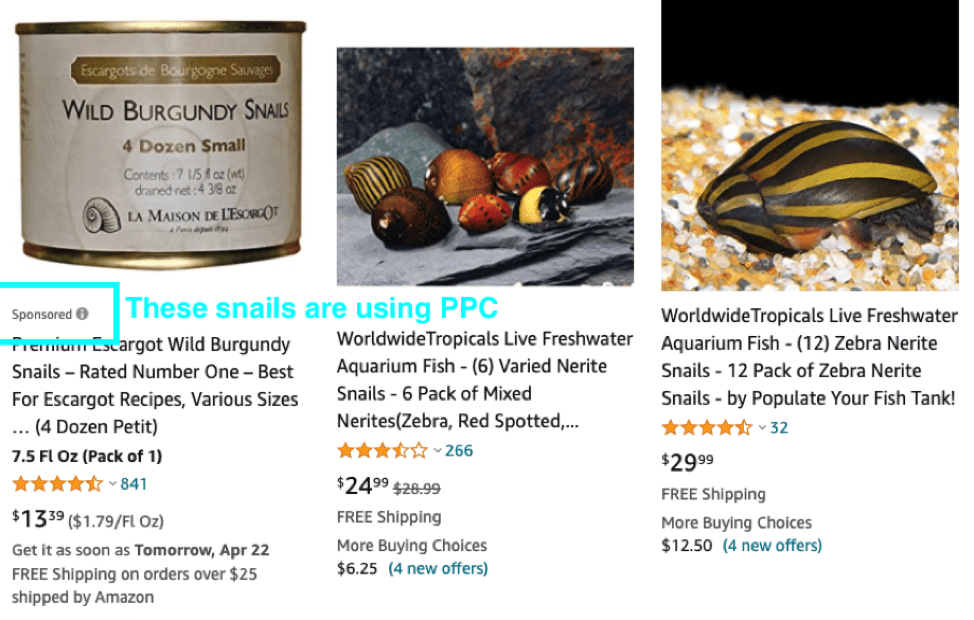
I usually set up an Automatic PPC campaign when I launch a new product, as Amazon then promotes your product using keywords they think fit your product. It is also a good idea to target your favorite keywords in a manual campaign.
Don’t worry about this part too much just yet, I cover PPC in my other articles and you can go to read those when you have your products ready for launch.
Product Reviews
It is really important to get as many product reviews as possible, as having more reviews will increase your conversion rate as customers get more trust in your products.
You can ask for a review after a customer has placed an order, or you can use a follow up software tool to help you get more reviews. Helium 10 and Sellerboard include follow up software in their package of software.
Customer Service on Amazon
One of the best ways to get product reviews, and one that many sellers use, is to send emails to people who buy your products and ask for a review.
You can’t ask for a good review or incentivise the review e.g. “Leave a good review for 20% off your next order” but you can ask for an honest review. You also cannot put links to your own website on the email.
In my email I simply say thanks for buying the product and give them some tips on how to look after the product, or some additional information about that product. For example, if I was selling some leather horse equipment I might give some advice on how to keep the leather soft and how to wax it.
I could also ask the buyer to get in touch with me if they are having any issues. This way I can try and avoid bad reviews.
In Helium 10 there is a tool called Follow Up which can send these emails for you. You can also use the ‘request a review’ feature inside the Amazon orders on your order page. I have tried this and I am not sure how well it works to be honest, but it’s worth a shot!
Unfortunately you can’t email customers directly through Amazon Seller Central, you need to use additional software (or do it manually).
Inventory Management
Once you start selling you’ll need to monitor your inventory levels. You really want to avoid going out of stock as it can hurt your sales ranking.
You can see your inventory levels in the inventory page in Seller Centra, but the way I love to track my inventory is using Sellerboard. Sellerboard is one of my favorite tools for selling on Amazon, firstly because it’s only $15 a month, and secondly it give you a real time view of your stock levels and it also gives you a profit and loss sheet so you can see how your business is performing.
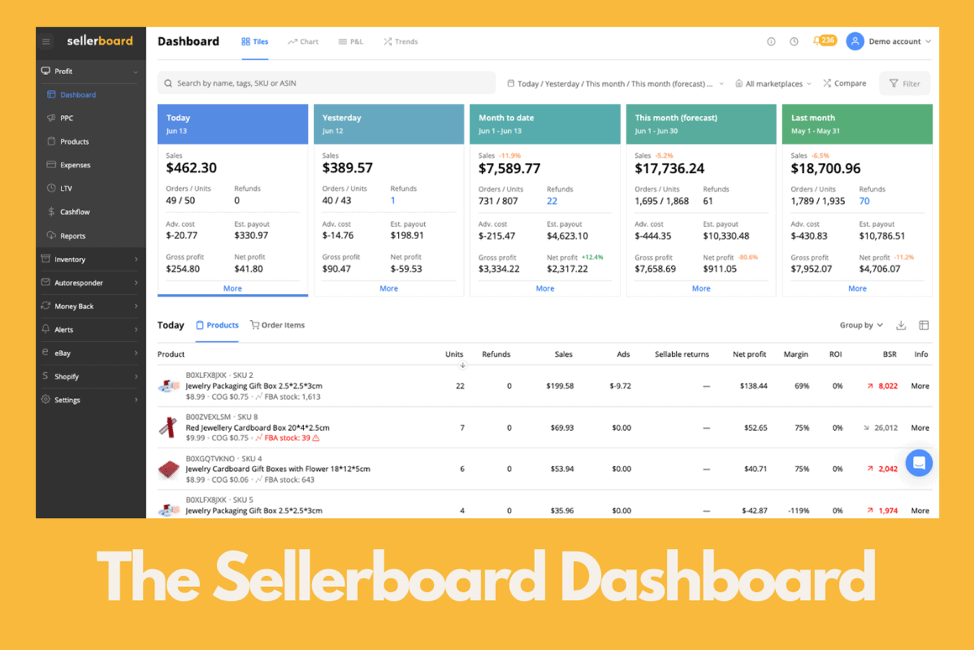
Amazon FBA Returns
One of the best parts about Amazon FBA is that Amazon handles all the customer service. This means you don’t need to worry about FBA returns as Amazon handles them for you.
One of the downsides is that Amazon make it very easy for customers to return products, which means the returns rate is higher than average. However, if you have decent products then this shouldn’t be an issue.
Amazon Brand Registry
Brand registry is a more advanced tactic. It essentially involves you getting a trademark and registering your brand with Amazon. The advantage of brand registry is you can use A+ or Enhanced Branded Content (EBC). Using A+ you can make your listings look like mini websites, which helps improve your conversion rate. I talk about much more in my brand registry article here.
Time to Get Started
Wow, that guide was a bit longer than I’d planned! So that’s a whistle stop tour, or step by step tutorial of what’s involved in setting up an Amazon FBA online business! If you would like more information, you might find my weekly newsletter useful – it’s jam packed full of tips for building and growing an Amazon FBA business.
If you’re looking for a bit more hands-on guidance as you set up your FBA business, why not check out my Amazon Fundamentals programme – It breaks down all the essential steps to selling on Amazon FBA, from finding a product through to getting your first sale in an easy to follow roadmap. the training videos are easy to follow along and will tell you everything you need to know to get started on your selling journey.
Good luck with your Amazon business! Let me know how you get on.
You might also like my Amazon FBA Tutorial:

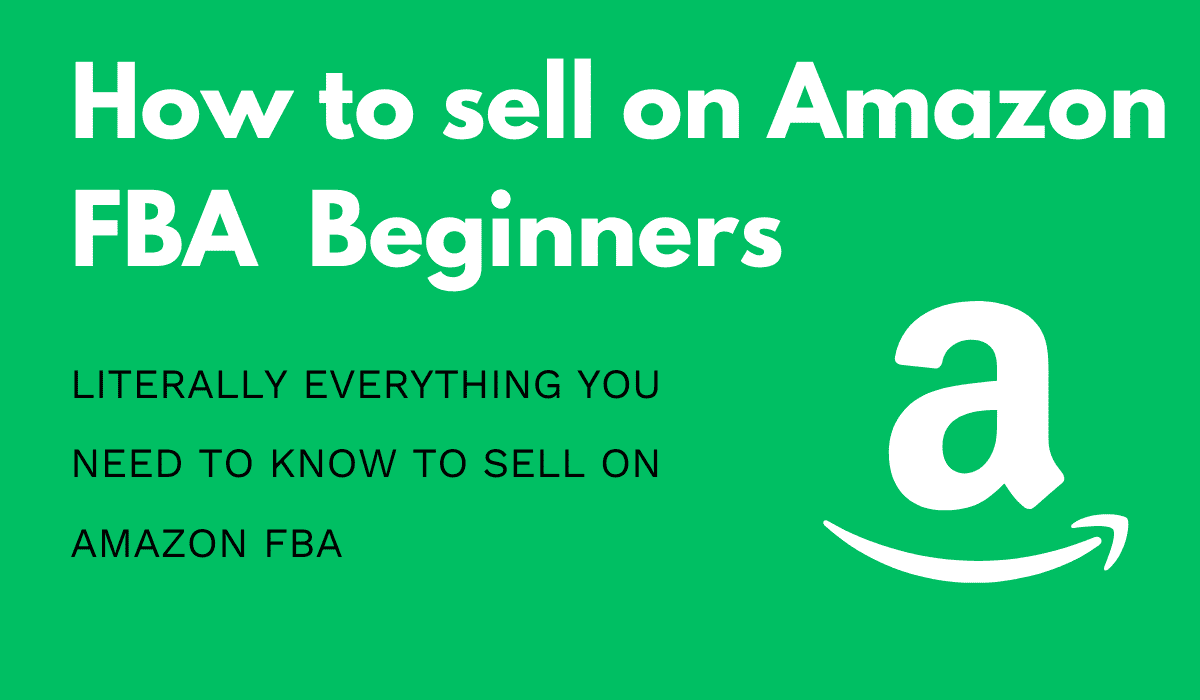
Thanks for sharing this content. The content help the sellers to understand the how to sell on Amazon FBA. It will help them to boost Amazon marketing.
Thanks Gauthami, really glad you found it helpful!
Have you ever considered about adding a little bit more than just your articles? I mean, what you say is important and all. But imagine if you added some great images or video clips to give your posts more, “pop”! Your content is excellent but with pics and video clips, this site could undeniably be one of the most beneficial in its field. Wonderful blog!|
Amazing! Its in fact amazing piece of writing, I have got much clear idea regarding from this post.|
Quality posts is the key to be a focus for the visitors to visit the site, that’s what this site is providing.|
It’s nearly impossible to find educated people about this subject, but you sound like you know what you’re talking about! Thanks
Amazing write up! Thanks for this submit
Awesome article.